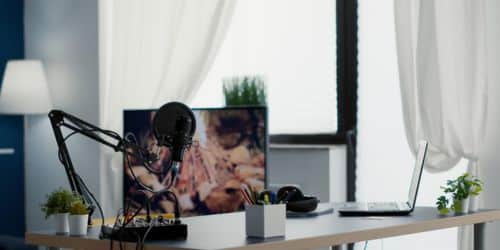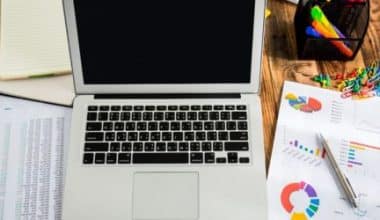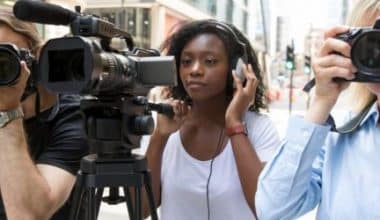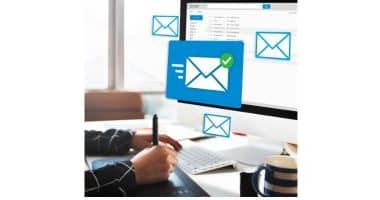Podcasting has become a popular medium for sharing tales, knowledge, and conversations. Did you know that as of 2024, there are over 2 million active podcasts and over 48 million podcast episodes available online? When I first heard about podcasting, I was completely overwhelmed by the sheer number of equipment options. It seemed like you needed to be a tech whiz to get it correctly. But here’s the good news: starting a successful podcast doesn’t require a tech whiz or having a professional studio. Whether you’re starting or have a few episodes under your belt, this guide will walk you through the basic podcast equipment for beginners and help you discover the best fit for your budget and goals.
Key Takeaways
- Start with reliable options like the Blue Yeti or Audio-Technica ATR2100x. These microphones provide excellent sound quality without breaking the bank, making them perfect for beginners.
- Opt for headphones like the Audio-Technica ATH-M50x or Sony MDR-7506. Good headphones are crucial for accurate sound monitoring, helping you catch issues early in your recordings.
- An audio interface, such as the Focusrite Scarlett 2i2 or PreSonus AudioBox USB 96, is essential for converting analog microphone signals to digital, ensuring high-quality sound.
- While not essential, items like pop filters, boom arms, and shock mounts can significantly enhance your recording quality and comfort. Don’t forget to invest in quality cables and stands.
- Whether it’s a closet or a dedicated room, make your space acoustically friendly by using DIY soundproofing techniques. Simple additions like foam panels and soft furnishings can drastically improve your sound quality.
Why so Much Fuss About Podcast Equipment?
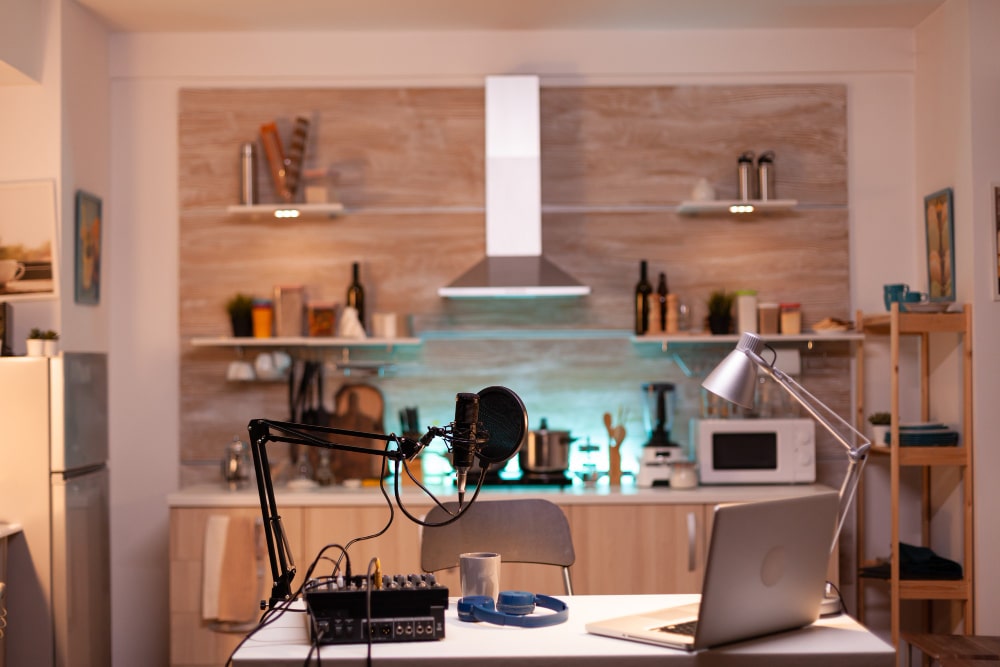
I know you must be asking, isn’t a computer enough to get started? Okay, technically, sure. However, it may not be sufficient if you want to create a great-sounding podcast that does not turn off potential readers due to poor audio or production. As a result, there is a strong emphasis on selecting the appropriate equipment.
Podcasting may be difficult at first, but let’s break it down. However, if you are enthusiastic about your business, hobby, or lifestyle, podcasting allows you to share your knowledge with a global audience. Why, because the world is hungry for information, especially when it is presented in an accessible and engaging manner. In summary, to begin podcasting at a basic level, all you need is a smartphone.
Podcast Equipment: Factors to Consider Before Purchasing
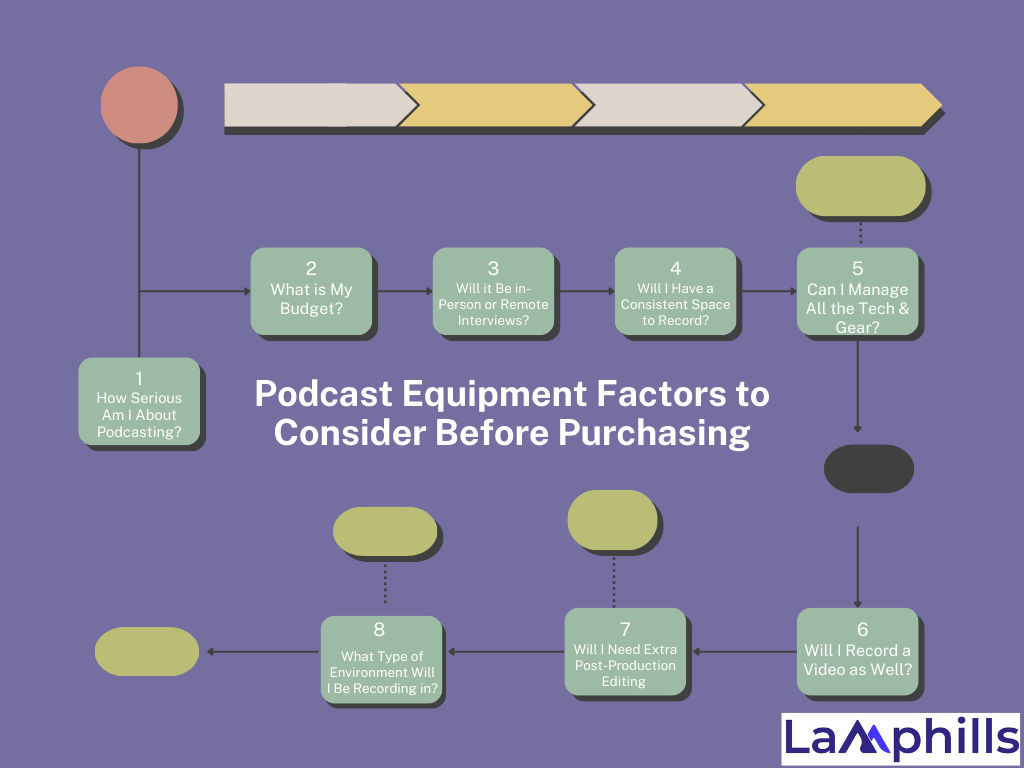
Still, if you want to join the ranks of broadcasting pros who make a living from podcasting, you’ll need the necessary equipment. Likewise, if you are passionate about a subject, you will not need to spend a lot of time preparing for your podcast.
After all, if you want to do this for the long haul, you must be professional. It is critical to choose who will be engaged and how much time, energy, and money you are willing to invest to make it a success. Here are some questions to ask yourself before beginning your podcasting journey.
#1. How Serious Am I About Podcasting?
Are you approaching podcasting as a hobby, or do you aim to make it a full-time career? If you intend to podcast for the amusement of a small group of friends and family, or if you are a business leader looking to communicate updates with the team, there is no need to go to extremes of effort and money. However, if you want to be a prominent podcaster, having the proper setup from the start will provide you with credibility, which is required for creating a following, then go ahead to purchase.
#2. What is My Budget?
Amateurs who want to have fun exploring the world of podcasting don’t need the brightest and shiniest equipment to share information with the world. You don’t need to spend much to get a message across the airwaves. However, a bigger budget means better quality. When you work out how serious you are about your future in podcasting, you can then match the level of your intended professionalism with the money required to meet these expectations.
#3. Will it Be in-person or Remote Interviews?
Some podcasters can fill a section on their own, but listeners prefer podcasts with at least two people who bounce questions and answers back and forth. Banter and humor among hosts are more interesting than a monologue. This means, that when podcasting with a co-host or guest, each participant will need their microphone and headphones. However, there are additional problems and costs to accomplishing this with a co-host or visitor at a remote location. You should consider employing a remote platform that captures each participant and syncs the tracks so you don’t have to edit everything together later.
#4. Will I Have a Consistent Space to Record?
Few people have access to a professional studio, yet podcasting does not require one. All you need is a setting with as little noise and echo as feasible. Choose a room with soft furnishings rather than bare walls, which reflect sound to the microphone. A bedroom is good for recording since the bed acts as a large sound absorber, and pillows can be put around the microphone to prevent sound from being deflected. Recording your podcast late at night is also a good option because there will be less traffic and annoying background noise.
#5. Can I Manage All the Tech & Gear?
Jumping into podcasting can seem overwhelming at first. Fortunately, with podcasting being so popular, many step-by-step online resources and tutorials are available. Microphones are designed to plug straight into a computer or mixer, and remote recording platforms have an intuitive interface that makes it easy to set up. It will be easier than you imagine, so don’t talk yourself out of it; just get started!
#6. Will I Record a Video as Well?
Recording video alongside your podcast is a simple method to provide additional material for social media. Adding video takes your listeners into your recording environment, which aids in the development of a connection with your audience. Posting video content from your podcast to YouTube exposes your show to a completely new audience. The simplest approach to include footage from an in-person podcast is to shoot video with a DSLR camera and record audio with a separate microphone.
You then merge and edit the video and audio together. To create a video podcast with a distant co-host or guest, press record to capture visuals from the Zoom or Skype screen while recording voice locally. After that, audio and video must be combined in post-production. This editing will take more time and may add to the production costs, but it’s an effective way to give extra value to your podcast’s audience.
#7. Will I Need Extra Post-Production Editing
Some of the most successful podcasts, such as This American Life, Serial, and Radiolab, use sound effects and music to stir emotions and add spice to the listening experience. So, when you have enough experience with standard podcasting, take it to a more professional level by introducing appropriate audio. This brings another layer of entertainment to podcasts, especially ones based on a storytelling format.
#8. What Type of Environment Will I Be Recording in?
Podcasting is audio-based, so listeners want to hear the presenter’s voice without annoying background sounds. Unless you are doing interviews on location, podcasts are rarely recorded outdoors. They require an environment that is free of distracting background sounds. To solve this, hire a studio, make a permanent podcast room in your home, or set up a temporary indoor area for occasional recordings.
Examples of Podcast Equipment and Services
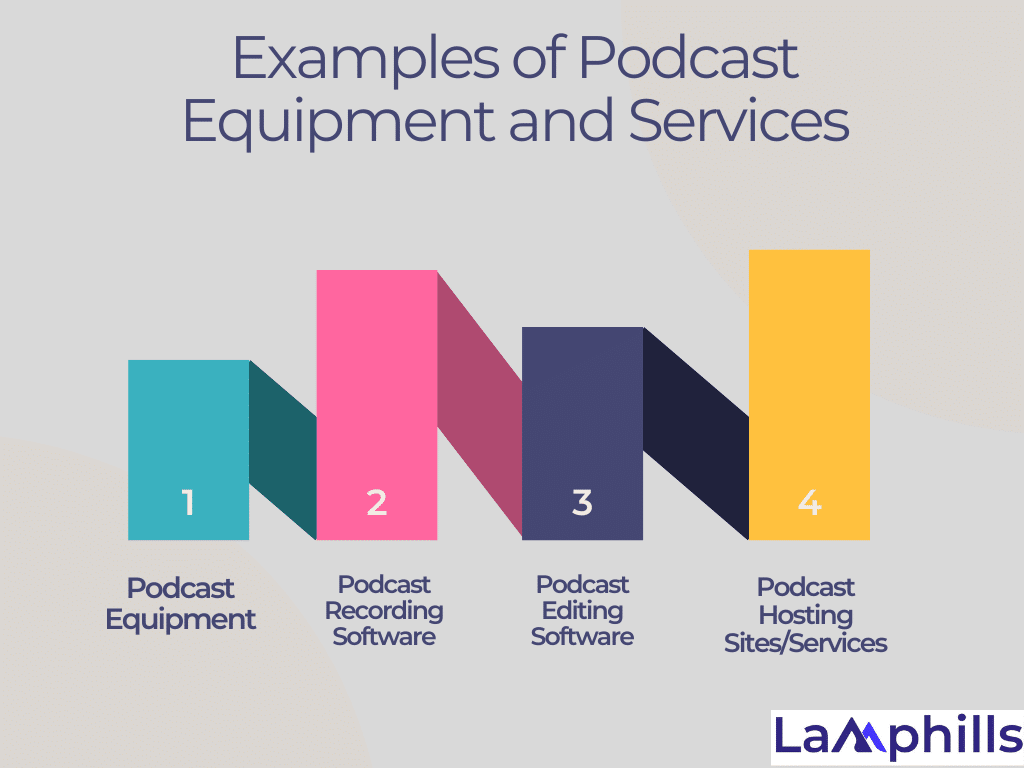
The amount of podcast equipment required is determined by the level of sophistication desired for your audio. Of course, you will need a microphone, but unless you are recording directly to a computer, you will also require a recorder. If you have a recorder with numerous voices, you’ll need a mixer. Using little equipment simplifies the procedure, but gives you less control over the output. Extra equipment gives flexibility but incurs hefty costs. I’ll categorize the tools and services into four types: podcast recording equipment, podcast recording software, podcast editing software, and podcast hosting websites for a better understanding,
#1. Podcast Equipment
To take your podcast show from good to great this year, you need to have the right equipment.
A. USB or XLR Microphone
To record your podcast, you will first need a microphone. The two most common types are USB microphones and XLR microphones. USB microphones can connect to your computer via a USB connection. They are simple to operate and require little setup.
If you want to have more control over your audio, consider using an XLR microphone and cable to improve sound quality. The Audiotechnica ATR2100 microphone is a popular podcasting microphone that may be connected via USB or XLR. The RODE PodMic is an affordable XLR microphone that produces studio-quality audio.
B. Audio Interface
If you want to use an XLR connection, you will need an audio mixer to connect your microphone and computer. A mixer or audio interface not only connects directly to your computer, but it also provides you with extra volume control and editing options.
The Focusrite Scarlette 2i2 is a basic audio mixer that connects XLR microphones to a computer via a USB-C cable. This mixer has basic volume controls for up to two microphones.
For more studio controls, check out the RODECaster, which can connect up to four microphones, has eight programmed settings, and supports Bluetooth for phone interviews.
C. Windscreen or Pop Filter
Once you select your microphone, make sure you get a corresponding windscreen or pop filter to minimize popping sounds and record higher-quality audio that needs less editing to sound great.
D. Studio-Quality Headphones
Headphones are a must for podcasters, especially those who record interviews remotely. Wearing headphones while recording allows you to hear how the recorded audio will sound in real-time so you can make adjustments as needed to have the highest quality recording.
If you record virtual interviews on your computer, you’ll want to make sure both you and your guests use headphones to avoid having the mic pick up any sound that may come from your computer’s speaker causing an unpleasant echo.
E. Adjustable Microphone Arm Stand
Neewer Boom Mount
This super-adjustable boom mount is made of steel and can be attached to any table. Once you have a microphone, headphones, and audio interface, you’ll want to consider getting a microphone armstand. A microphone stand will make it easier for you to record your podcast, so you aren’t chained to your desk or have to sit in an awkward position. Most microphones will come with an adapter that’ll connect with any microphone arm stand. Before you buy a new stand, make sure you have that adapter
F. Video camera
If you want to take your podcast to the next level, consider capturing video as well. This type of stuff makes for excellent YouTube videos and social media updates. You’ve already done the job of developing the content, so make the most of it.
Video podcasts typically use their cameras in one of two ways: they either place the camera in a single location and capture the entire podcast from that position, or they set up many cameras in the same room. A single camera makes editing simple; there is none. The use of multiple cameras necessitates the incorporation of various viewpoints into the video clip, but the result is quite fascinating.
#2. Podcast Recording Software
Now that you have all the equipment to make your podcast the best it can be, you’ll need to make sure you’re using the right recording software.
A. Skype
Price: Free
With Skype, you can record video and audio right in the program. When you’re on a call, you can click the three dots on the bottom right and then hit “Start Recording. Skype is a great option for podcasters because it’s free and easy to use. There are also other options if you want better audio quality. For instance, you can download recording software on your computer or buy an external digital recorder.
B. Zoom
Price: Free+
Zoom is another great free alternative (for calls lasting up to 40 minutes). You can easily record directly in the program by clicking the “Record” button and selecting where you want to save your audio file.
Skype and Zoom are somewhat similar possibilities, although their recording files differ. Skype will provide you with a mono file, which means both your and your interviewee’s sides of the discussion are recorded on the same audio track. Zoom, on the other hand, separates both sides of the call, resulting in two distinct audio recordings. This is useful for trimming and editing in post-production.
#3. Podcast Editing Software
Once you record your podcast, it’s time to edit it. As you’ve read above, many software includes both recording and editing capabilities. Below are some tools known for editing, rather than recording.
A. Adobe Audition
Price: $20/month+
Adobe Audition is an excellent mid-level audio editing application. You may generate, record, mix, edit, and recover audio files. It provides high-quality sound as well as full tools for producing polished audio. Adobe Audition, for example, includes a podcast template that allows you to create a multi-track recording with the ability to mix and edit several audio tracks and voices. In addition, you can work in both waveform and multi-track editors for more comprehensive editing.
B. Audacity
Price: Free
Audacity is an outstanding, free podcast editing tool. It’s extremely simple if you intend to use only one take with a few trims. The user interface is simple to use and ideal for beginners. However, because of the program’s simplicity, making many cuts or moving sounds around becomes more difficult.
This choice is ideal for novices due to its straightforward cut, copy, and paste functionality. It is not the finest quality sound, but it does the job.
C. Descript
Price: Free+
If you can edit a Google Doc, you can also edit a podcast. That is the idea behind Descript, a text-based audio and video editing application. To utilize Descript, upload your file and receive an AI-generated transcription. You can then analyze the transcript and make adjustments in real-time. Descript also has a feature that employs an AI-generated version of your voice, allowing you to add words to your audio by merely typing. Descript is exceptionally simple to use for beginner podcasters and those with no audio editing knowledge.
#4. Podcast Hosting Sites/Services
Now that you’ve bought your equipment, and recorded, and edited your podcast, you may be wondering what’s next. After you’ve produced your podcast, it’s time to find the right hosting site and service to publish it on.
A. BuzzSprout
Price: Free+
BuzzSprout is a great hosting option because it lists your podcast in all of the major podcast directories, including Apple Podcasts, Spotify, Google Podcasts, and Stitcher.
It also provides comprehensive data, allowing you to track the growth of your podcast. You may view data for your listeners, total plays over time, and where people listen to your podcast. Additionally, you can transcribe your podcast in BuzzSprout. Paid options include unlimited storage and episodes hosted eternally.
B. Libsyn
Price: $5/month+
Libsyn is a hosting service that will get your podcast published on your audience’s favorite apps and platforms.
A unique feature is its monetization options. For example, it offers premium content subscriptions and opt-in advertising. These options keep you in control and allow you to customize your monetization. You’ll also have access to detailed audience statistics, so you can also see what’s working and what isn’t.
How to Set Up a Podcast Studio
Once you have your equipment, recording and editing software, and hosting services, it’s time to figure out where you’re going to record your podcast.
You’ll want to set up a podcast studio. This can be as basic as having the right equipment in any room or as advanced as creating a dedicated space for recording. To set up a podcast studio, follow these steps:
Step 1: Buy The Equipment
This comprehensive checklist below will help you set up a budget-friendly podcast studio, ensuring high-quality recordings and a professional setup.
Before you can build up your studio, you must first acquire the necessary equipment. You will require a microphone, microphone arm, headphones, audio interface, desks, and seats. You might also consider purchasing more than one of these items in case you decide to invite people in for interviews.
Step 2: Prepare the Room for Sound Conditioning
To get the finest sound, try purchasing soundproof foam wall panels to attach to the walls. This prevents the sound from bouncing off the walls. Additionally, you can purchase pop filters for the microphones to eliminate popping sounds.
Step 3: Set up Lighting and Cameras
Many podcasters choose to record their shows and upload them to YouTube or other social media platforms. If you wish to achieve this, you will need to install lighting and cameras.
Anyone can create a podcast. That is why you want your podcast to stand out among the others. To take your podcast from okay to amazing, make sure you have the proper equipment, software, and studio setup.
How much does it cost to start a podcast?
The truth is you can start a podcast for free, but I recommend investing in at least a good microphone, headphones as well as recording software. These are your two most essential pieces of equipment to start a high-quality podcast. Overall, you can get a microphone for around $100 or more, headphones for around $50 or more, and recording software, In total, you can start a podcast for as little as $150-200 dollars but I do recommend investing more if you’re interested in growing your show.
Do I need special equipment to do a podcast?
Technically, you can record a podcast from a computer or a phone without using any extra equipment. You can just record using your built-in recorder, although this will not always produce the greatest results. For the greatest results, I recommend starting with a high-quality microphone, headphones, and specialist recording software. As your podcast grows, you may want to expand your equipment bundle to include extra microphones, a mixer, and other items from our list above.
Can I do a podcast by myself?
Yes! You can totally create a podcast on your own. We recommend you think about your podcast topic and podcast format first, to make sure your show is suitable as a one-man show
Do podcasters make money?
Podcasting is a lucrative business idea with some top podcasters even signing huge deals for their show.
Wrapping Up
Some people listen to podcasts for enjoyment, while others listen to learn about their careers or lifestyle. A podcast is an opportunity to give them what they want. If you have a passion, there’s a good chance that others share it and are looking for a connection.
The correct podcast equipment provides you with the necessary tools to launch your show. Begin with affordable microphones, headphones, and recording software. As your audience grows, you can always upgrade with more powerful equipment such as visuals and portable microphones. Only a little investment can go a long way to making your podcast kit a success. Once your equipment kit is all setup, you’re ready to start recording. What are you waiting for? Start creating podcasts today.
